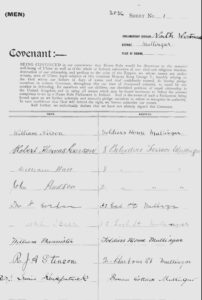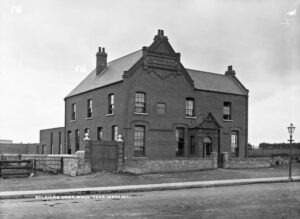A recent search of the Ulster Covenant for a family from Ulster led to a surprising discovery.
In 1912 Liberal British Prime Minister Herbert Asquith, in desperate need of the support of John Redmond’s Irish Parliamentary Party, proposed a third Home Rule Bill – providing self-government for Ireland within the United Kingdom of Great Britain and Ireland.
Unionists responded with fierce opposition to Home Rule. On Ulster Day, the 28th September 1912, the Unionists of Ulster, with great ceremony and fervour, put their name to the Ulster Covenant. The Covenant was signed by 237,368 men, with 234,046 women signing the accompanying women’s declaration.
Signing the Ulster Covenant constituted a solemn and binding oath to resist Home Rule, with signatories pledging:
“to stand by one another in defending, for ourselves and our children, our cherished position of equal citizenship in the United Kingdom, and in using all means which may be found necessary to defeat the present conspiracy to set up a Home Rule Parliament in Ireland.”
Nearly half a million signatures to the covenant and women’s declaration were collected from across society, the vast majority within the province of Ulster.
However, in Dublin in the offices of the Irish Unionist Alliance at 109 Grafton Street the Ulster Covenant was signed by 2,000 men who could prove that they were born in Ulster. It was also signed in other major cities in the United Kingdom and around the world – including the unlikely location of Mullingar, the county town of County Westmeath.

Ulster Covenant Signatories for Mullingar. Courtesy of PRONI
The signatories of the Ulster Covenant in Mullingar were not members of established and well-known protestant families from the area such as local merchants or the aristocratic families, and in fact, the majority could not be found in Mullingar in the 1911 census, enumerated less than a year and half earlier. And not in keeping with the purpose of the Ulster Covenant, not all were born in Ulster. Names were signed not in a public location, but in private homes throughout the town, including Belvedere Terrace, Earl Street (now Pearse Street), Harbour Street and the Soldier’s Home on Military Road (now Ashe Road) – which stood where Fair Green Shopping Centre is found today.
The agent in charge of collecting the signatures, William Nelson, was also the first to sign, and resided in the Soldier’s Home. Known as Sandes Homes for Soldiers, named for their founder Elise Sandes, there were over 30 such homes in Ireland by 1912, run by evangelical Christians to draw young soldiers away from the pubs, brothels and gambling dens. These soldiers homes instead offered friendship, entertainment and self-improvement. Whether opposing Home Rule fell within this purview is unclear.

Soldiers Home, Mullingar. Courtesy of the NLI Photographic Archive, L_ROY_10342
Another man signing the Covenant in Mullingar was John Hudson of 2 Belvedere Terrace. At the time of the 1911 census, John was found living as a boarder with the Hutchinson family at 23 Greville St (now Oliver Plunkett Street). The Hutchinsons were a prominent local merchant family. John Hudson was aged 20, born ca. 1881 in Co. Wexford, and worked as a draper’s assistant, presumably in T.L. Hutchinson’s drapery shop.
Of note, although the Hutchinson family were Methodists, no members of the family signed the Ulster Covenant – appropriately so since none were born in Ulster, but possibly also protecting the family business which served a largely Catholic, and pro-Home Rule community. Their assistant and boarder, John Hudson, was also not born in Ulster, but this didn’t appear to deter him from signing the Covenant.
No additional signatures, besides William Nelson, John Hudson and the other seven Mullingar signatories, were collected in County Westmeath, although some originally from County Westmeath did sign elsewhere. Other counties of Ireland, not in Ulster, in which signatures were collected included:
● Wicklow
● Waterford
● Sligo
● Meath
● Louth
● Mayo
● Limerick
● Leitrim
● Kilkenny
● Kildare
● Dublin
The Home Rule Bill passed but its implementation was postponed at the outbreak of WWI. In the end, it was never enacted and was eventually superseded by a fourth Home Rule bill in 1920 – the Government of Ireland Act. This act provided for the partition of Ireland into two self-governing political entities – Northern and Southern Ireland. The latter would become the Irish Free State and eventually the modern Republic of Ireland.
The Ulster Covenant has been indexed and digitised, and is available to search online on the website of the Public Record Office of Northern Ireland (PRONI). It is also available to search on Ancestry (subscription required).
